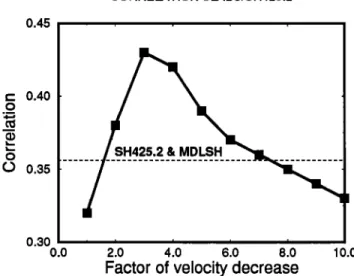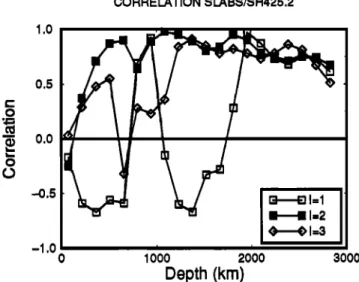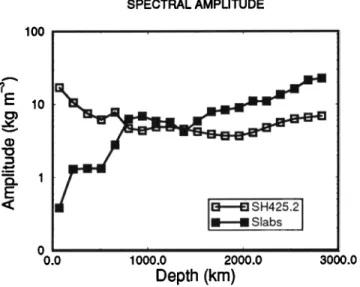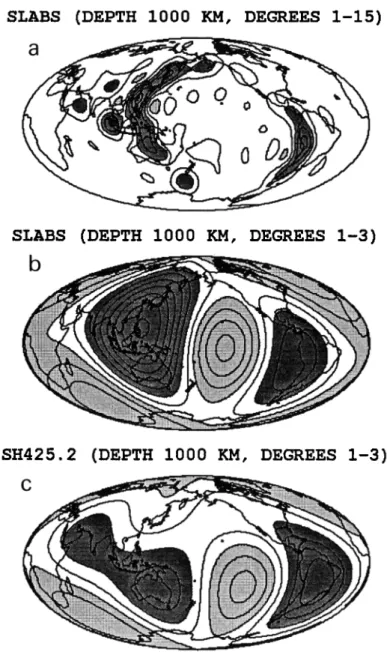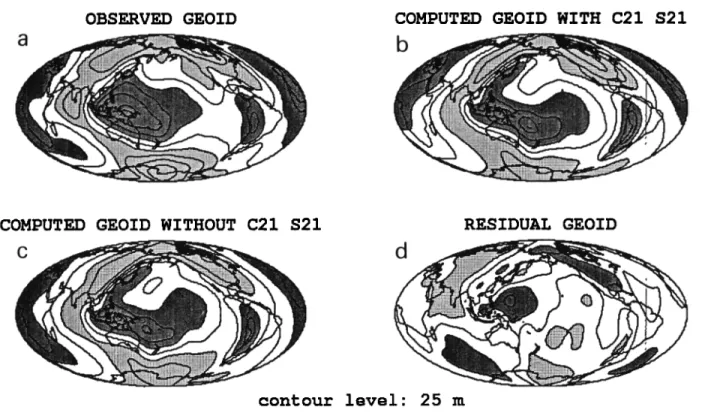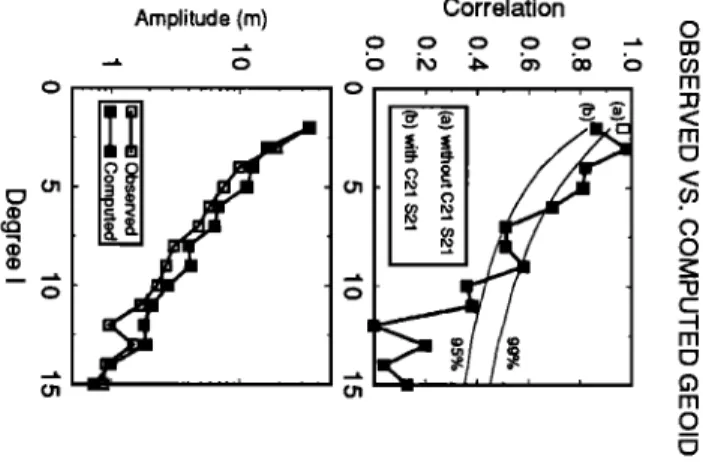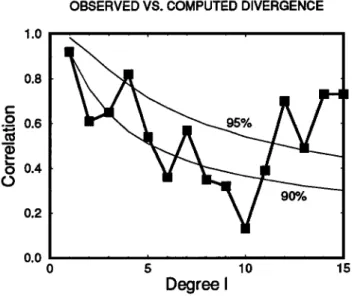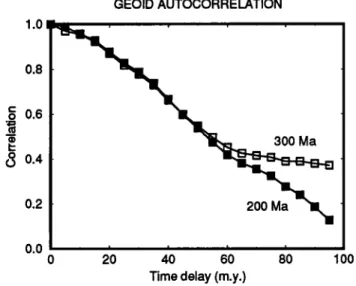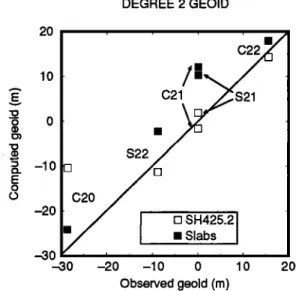HAL Id: hal-02046765
https://hal.archives-ouvertes.fr/hal-02046765
Submitted on 3 Feb 2021
HAL is a multi-disciplinary open access
archive for the deposit and dissemination of
sci-entific research documents, whether they are
pub-lished or not. The documents may come from
teaching and research institutions in France or
abroad, or from public or private research centers.
L’archive ouverte pluridisciplinaire HAL, est
destinée au dépôt et à la diffusion de documents
scientifiques de niveau recherche, publiés ou non,
émanant des établissements d’enseignement et de
recherche français ou étrangers, des laboratoires
publics ou privés.
A geodynamic model of mantle density heterogeneity
Y. Ricard, M. Richards, C. Lithgow-Bertelloni, Y. Le Stunff
To cite this version:
Y. Ricard, M. Richards, C. Lithgow-Bertelloni, Y. Le Stunff. A geodynamic model of mantle
den-sity heterogeneity. Journal of Geophysical Research, American Geophysical Union, 1993, 98 (B12),
pp.21,895-21,909. �10.1029/93JB02216�. �hal-02046765�
JOURNAL OF GEOPHYSICAL RESEARCH, VOL. 98, NO. B12, PAGES 21,895-21,909, DECEMBER 10, 1993
A Geodynamic Model of Mantle Density Heterogeneity
YANICK RICARDDe'partement Terre-Atmosph•.re-Oce'an, Ecole Normale Supdrieure, Paris, France MARK PalCHARDS 1 AND CAROLINA LITHGOW-BERTELLONI 1 Department of Geology and Geophysics, University of California, Berkeley
YVES LE $TUNFF :•
Ddpartement Terre-Atmosph•re-Ocdan, Ecole Normale $upe'rieure, Paris, France
Using Cenozoic and Mesozoic plate motion reconstructions, we derive a model of present-day mantle density heterogeneity under the assumption that subducted slabs sink vertically into the mantle. The thermal buoyancy of these slabs is estimated from the observed thermal subsidence
(cooling) of oceanic lithosphere. Slat) velocities in the upper mantle are computed from the local convergence rate. We assume that slabs cross the upper/lower mantle interface and continue
sinking into the lower mantle witIx a reduced velocity. For a velocity reduction factor between :2
and 5, our slab heterogeneity model is as correlated with current tomographic models as these models are correlated with each other. We have also computed a synthetic geoid from our density
model. For a viscosity increase of about a factor of 40 from the upper to lower mantle, our model
predicts the first 8 spherical harmonic degrees of the geoid witIx statistical confidence larger than 95% and explains 84% of the observed geoid assuming that the model C21 and S21 terms are absent due to a long relaxation time for Earth's rotational bulge. Otherwise, 73% of the geoid
variance is explained. The viscosity increase is consistent witIx our velocity reduction factor for
slabs entering the lower mantle, since downwelling velocities are expected to scale roughly as the logarithm of viscosity (loge 40 - 3.7). These results show that the history of plate tectonics can explain the main features of the present-day structure of the mantle. The dynamic topography
induced by this heterogeneity structure consists mainly of about 1-kin amplitude lows concentrated along the active continental margins of the Pacific basin. Our model can also be used to predict
the time variation of mantle heterogeneity and the gravity field. We find that the "age" of the
geoid, defined as the time in the past herore which the geoid becomes uncorrelated witIx the present
geoid, is about 50 m.y. Our model for the history of the degree 2 geoid, which is equivalent to the
history of the inertia tensor, should give us a tool to study the variations in Earth's rotation pole indicated in paleomagnetic studies.
INTRODUCTION
Convection in Earth's mantle gives rise to horizontal den- sity variations which cause lithospheric plate motions at Earth's surface. If the oceanic lithosphere is assumed to be the cold upper boundary layer for global mantle convec- tion, then convection models predict that regions of litho-
spheric downwelling
("subduction
zones") should be un-
derlain by cold descending
plumes
("slabs"). If the man-
tie is heated largely by internal radioactivity, then these downwelling plumes are expected to dominate mantle het-
erogeneity
structure [McKenzie ½• al., 1974], with hot up-
welling plumes playing a relatively minor role. This basic
scenario
for mantle dynamics
is supported
by a broad spec-
trum of evidence
[Davies
and Richards,
1992]: Deep Wadaft-
Benioff zone seismicity shows that the lithosphere descends
to great depths beneath
subduction
zones
and the large-scale
configuration of these subduction zones remains fairly sta-
ble in time [Richards
and Engetbretson,
1992]. Mid-ocean
ridges
behave as unstable,
passive
upwelling
features
whose
•Now at Geophysics Program, University of Washington, Seattle.
•2Now
at Department
of Geology
and Geophysics,
University
of
California, Berkeley.
Copyright 199:3 by the American Geophysical Union. Paper number 93JB02216.
0148-0227 / 93/93 JB- 02216505.00
thermal signature does not appear to extend deeper than
about 100 km [Zhang and Tanimoto, 1991]. Mantle plumes
beneath hotspots, which may arise from the core-mantle
boundary [Morgan, 1971], appear to account for only a mi-
nor fraction (~10%) of Earth's internal heat budget [Davies,
1988a; Sleep, 1991].
Adopting this point of view results in a simple, testable hy- pothesis: The heterogeneity structure of the mantle should be largely the result of past subduction. The purpose of
this paper is to test this hypothesis by constructing a model
of mantle heterogeneity based on the history of subduc-
tion as revealed by global plate reconstructions for the past
~180 m.y., i.e., for the Cenozoic and Mesozoic eras. Our approach is in marked contrast with other, observationally based efforts to model mantle heterogeneity, which have re-
lied mainly upon seismic tomography to infer mantle density structure [e.g., Hager et al., 1985; Forte and Peltlet, 1987;
Ricard et al., 1989; Hager and Rich, ards, 1989; Ricard and
Vigny, 1989; Forte et al., 1992]. The main feature that our
model has in common with past efforts is that we also at- tempt to constrain mantle viscosity structure by comparing
the observed and predicted gravitational fields [Ricard et al.,
1984; Richards and Hager, 1984].
Predicting thermal heterogeneity in the mantle due to
subduction is rather straightforward, because of the regu-
lar dependence
of ocean bathymetry on plate age [Slater
and Francheteau, 1970]. This provides a direct measure of the negative plate buoyancy due to cooling and follows log-
21,896 RICARD ET AL.: GEODYNAMIC MODEL OF MANTLE HETEROGENEITIES
ically from the assumption that the oceanic lithosphere is a
thermal boundary
layer [e.g.,Davies,
1988b]. Hager [1984]
used this assumption to derive an excellent fit to the "in-
termediate" wavelength
geoid (spherical
harmonic degrees
4-10) based upon the location of subducted
slabs in the up-
per mantle and transition zone revealed by deep seismicity.
One of the main conclusions of Hager's study was that there exists a significant increase of viscosity between the upper
and lower mantle (a factor of ,,-30-100). However,
this up-
per mantle slab still left unexplained the largest part of the geoid signal, which occurs at harmonic degrees 2-3. This component has subsequently been modeled as arising from lower mantle density structure imaged by seismic body-wave
tomography
[Dziewonski,
1984; Hager and Clayton, 1989;
Tanimoto, 1990; Su and Dziewonski, 1991]. Geodynamic
modeling again indicates a viscosity increase from the up-
per to the lower mantle [Hager et al., 1985].
Following on an earlier suggestion by Chase and Sprowl
[1983], Richards and Engetbretson
[1992] demonstrated
a
strong correlation between large-scale lower mantle seismic structure and the time-integrated history of subduction over
the past ,,-120-180 m.y.: Basically, the deep mantle ap-
pears to be cold (high seismic
velocity) where subduction
has occurred in the past. Interestingly, lower mantle het-
erogeneity and the geoid are only weakly correlated with
the present-day
snapshot
of subduction
zones
[Chase,
1979].
This is expected, since subduction zones have evolved con-
siderably during the Cenozoic. For example, both regional
[Grand, 1987] and global [Dziewonski,
1984] seismic
tomog-
raphy show high velocity in the lower mantle beneath the
North American craton, which is inferred to be the thermal
signature of the subducted Farallon plate [Engebretson
et
al., 1985]. Because
most subduction along western North
America ceased quite recently, this mantle structure, which is easily explained in terms of past subduction, cannot be predicted from the present-day configuration of subduction
zones. Clearly then, a geodynamical interpretation, or pre- diction, of •nantle heterogeneity structure must include the
time history of plate tectonics.
Here we take the work of Richards
and Engebretson[1992]
to its next logical step by using subduction zone reconstruc-
tions to create a history of mantle heterogeneity since Meso-
zoic time. Our model is unique in that we attempt to predict
not only the present-day mantle heterogeneity structure but
also its evolution in time. Full treatment of the temporal aspects of the model is delayed largely until a future pub- lication. However, the implications may be of considerable
interest, since knowing the time evolution of mantle struc-
ture allows one to predict, for example, the variations in the
planet's moment of inertia (" true polar wander") and global
sea level variations (the difference between geoid height and
dynamic topography).
In this paper we begin by describing in detail the essential features and assumptions of our mantle heterogeneity model. We then make a systematic comparison between this model and both seismic tomography and the geoid. We are able to achieve an excellent fit to both the geoid and tomography by using a •nantle viscosity structure almost identical to that
derived in our previous studies. Last, we consider the time
variation of mantle heterogeneity structure, and some of its
implications.
MANTLE HETEROGENEITY MODEL
We seek to construct a model of mantle heterogeneity based on the assumption that subducted slabs are the pri-
mary source of thermal buoyancy in the deep mantle. We
further assume that thermal diffusion does not significantly
alter the long-wavelength signature of subducted lithosphere
on the time scale of interest (~100-200 m.y.). The thermal
diffusion length scale for mantle rocks is only ~100 km for a
timescale of 100 m.y., i.e., the time it takes to form mature oceanic lithosphere. Since we are interested in •nodeling
mantle heterogeneity at wavelengths of thousands of kilo-
meters (e.g., for modeling
global seismic
tomography
or the
satellite geoid), heat diffusion
will be negligible
for at least
a few mantle transit times [Bunge and Richards,
1992].
Thus, rather than solving a full three-dimensional con-
vection problem constrained by plate motions (work in
progress), we construct a mechanistic
model by invoking
a simple parameterisation for the trajectory of subducted
slabs. Using a model of past plate motions, we introduce
the slabs into the mantle at the position in the hotspot ref- erence frame where they were subducted, at the time they
were subducted. Geological ti•ne is divided into 5-m.y. inter-
vals, and a slab tracer ("slablet") is assigned
for each small
amount of plate area subducted along a subduction zone
segment during each tithe interval. These "slablets" become
effective point mass tracers that sink through the mantle in a manner described below. To be self-consistent, our model
must include all the slabs over a period larger than the char- acteristic time needed for a slab to sink through the depth
of the mantle.
We have used a compilation of the past 200 m.y. of plate
•notions cronpiled
by Lithgow-Bertelloni
et al. [1993] us-
ing various
sets of reconstructions
[Gordon and Jurdy, 1986;
Engebretson et al., 1985, 1992; Scotese, 1992; Minster and Jordan, 1978; Larson and Chase, 1972; Larson and Pitman,
1972]. These reconstructions
are similar to those used by
Richards and Engebretson
[1992]. Models of slab-related
heterogeneity cmnputed frmn these different reconstructions
lead to very similar patterns of long-wavelength structure. Within the logic of our model, the early Mesozoic and Pa-
leozoic slabs should be close to the core-mantle boundary or essentially floating on it. It is well known that mass anomalies located close to a chemical interface are locally
compensated, thus giving no contribution to the geoid sig- nal or in driving convective •notions. These slabs are thus dyna•nically "dead" although they may influence the core-
•nantle topography or the seislnic velocity structure near the core-•nantle boundary.
To keep things simple, we suppose that slabs sink verti-
cally in the upper mantle with a velocity equal to the local
plate convergence rate. Allowing for a viscosity increase be-
tween the upper and lower mantle at a depth of 670 kin, we
reduce this sinking velocity by a factor less than or equal to the lower/upper mantle viscosity ratio, *ll/*lu, when the
slabs enter the lower mantle. In order to conserve thermal
buoyancy, we assume that the slabs are folded or thickened in proportion to this velocity reduction factor.
The appropriate a•nount of reduction in sinking velocity corresponding to a viscosity increase is questionable. An upper bound would be the viscosity contrast itself *ll/?lu
RICARD ET AL.: ([•EODYNAMIC MODEL c)F MANTLE HETEROGENEITIES 21,897
dependent Stokesian sinker. On the other hand, studies of
steady state convection
[Gurnis, 1986] and simple kinemati-
cally forced
flows [Richards,
1991] with viscous
stratification
suggest that a more appropriate velocity reduction factor
is loge(•ll/•lu). Using these estimates as upper and lower
bounds, we consider a range of slablet velocity reduction of,
e.g., 3.4 to 30 for a lower/upper mantle viscosity
contrast of
30. However, we expect a value toward the low side of this range based on the numerical simulations cited. In the mod-
els we construct, the lower/upper mantle viscosity contrast is the only true free parameter, with the slablet velocity re- duction factor restricted to a limited range dependent upon
the viscosity contrast.
We also neglect horizontal motions of slabs, consistent with our belief in a significant viscosity increase with depth. The lack of significant horizontal advection of subducted slabs in the lower mantle on the 100 m.y. timescale is also consistent with the very slow relative motion of hotspots
[Duncan and Richards, 1991], In this paper, we examine
spherical harmonic representations of mass anomalies up to degree 15, corresponding to half wavelengths greater than 1300 kin, so that lateral drift of downgoing slabs by the same amount will not substantially change our results. Therefore, the •nain source of apparently horizontal slab motion in the mantle is an artifact of trench migration, not deep mantle flow. This results in stone inclination of deep slab structure
in our model beneath the Americas due to tile westward
migration of tile active continental margins of North and South America since the beginning of the Mesozoic. Ill con-
trast, tile slabs beneath the western Pacific are more or less
vertical in our model due to tile remarkable stability of sub- duction zones in that region through tilne. Our model also results in some "refraction" of slab trajectories at 670 km due to the reduction in slablet sinking velocity.
In order to derive a mantle density distribution from our slablets, which represent pieces of subducted plate area, we must assign them an excess stirface density Art. For tile Cenozoic, wilere we have been able to make age estimates for subducted lithosphere, we use the use tile following ex- pression to assign tile surface density contrast due to sillking
slabs:
Art = 80 kg/m
2 v/age/90,
(1)
wilere the age is ill million years. This expression corre-
sponds to 3.5 km of isostatic thermal subsidence for 90 Ma
old oceanic lithosphere, which is roughly equivalent to a
lithospheric thickness of 100 kin. For tile Mesozoic we Call-
not make reliable subducted plate age estimates, so we as-
sign all Mesozoic
slabs
an age of 90 Ma in equation
(1) above.
Again, we neglect thermal diffusion, so we suppose that this excess density remains constant while a slab is sinking. hn- plicit in this assmnption is that tile thermal expansivity is inversely proportional to tile adiabatic mantle density at any given depth and therefore decreases by a factor of 2 within tile mantle. A somewhat higher reduction in thermal ex- pansivity may be more realistic [e.g., (?hopelas and Boehler,
1989], but this does not affect our model very much.
Finally, we also neglect variations in crustal and litho-
spheric thickness at the Earth's surface. These contributions
could easily be added a posteriori to improve tile uppermost
layer of our model (see later discussion).
COMPARISON WITH SEISMIC TOMOGRAPHY
We compute different present-day distributions of pale- oslabs in the mantle according to the velocity reduction fac- tor at 670-kin depth. For each velocity reduction factor, the
global correlation between the computed 3-D mass anoma-
lies and a global tomographic model is performed. The total correlation C between paleoslabs and mantle tomography can be defined by
C =
fEl,m
rim
$,;n
r2dr
v/
f E l , m
Tl
m
Ti•
n r 2
dr
•/ f E l , m
Sire
S
•m
r 2
dr
(2)
where Tim and Slm are the depth dependent harmonic co-
efficients
of tile tomography
and the slabs, respectively
(as-
terisk denotes the complex conjugate operation). Tile ill-
tegrals are performed over tile lower mantle since tile cor- relation between our slabs and upper mantle tomography is obviously independent of the velocity reduction factor at 670-km depth. For comparison, we have used tile to-
mographic models SH425.2 [Su and Dziewonski, 1991] and
MDLSH [Tanimoto, 1990]. We sum from 1 = 0 to 1 = 6 since
1 = 6 is the maxinmm harmonic degree present in MDLSH.
Figure 1 shows tile global lower mantle correlation be- tween our slabs and SH425.2 as a fimction of the velocity decrease at 670-kin depth. A clear maximum occurs for a slab velocity reduction factor of approximately s = 3.
With MDLSH tile best fit is obtained for s between 4 and
5, but the maximum correlation is only 0.24. Tile dotted
line of Figure 1 shows the global correlation, 0.36, between
SH425.2 and MDLSH. Tile disagreement between tile two
seismic models is larger than the disagreement between our
model and SH425.2.
The number of degrees of freedom involved in these com-
parisons is fairly large. At each depth, tile total number of degrees and orders is 48. Taking tile depth resolution of
0.45 CORRELATION SLABS/SH425.2 0.40 0.35 Fig. SH425.2 & MDLSH 0.30 0.0 2.0 4.0 6.0 8.0 10.0
Factor of velocity decrease
1. Global correlation over the lower lnantle between the density model deduced front Cenozoic and Mesozoic slabs and
the tomographic model SH425.2 [$u and Dziewonski, 1991]. This
correlation is maxinmm when we assume that the slab velocities
decrease by a factor 3 at 670 km depth. The dashed line shows
the global correlation between SH425.2 and Tanimoto [1990] to-
21,898 RICARD ET AL.: GEODYNAMIC MODEL OF MANTLE HETEROGENEITIES
tomography as 500 kin, the total number of coefficients has to be further multiplied by a factor of about 5. We cannot
directly identify the total number of degrees of freedom as
the total number of spherical harmonic coefficients, since the spectra are not flat. However, we think that the observed correlations between SH425.2, MDLSH, and our model are
indeed highly significant.
(For example,
a correlation
of 0.4
is significant
at the 95% confidence
level for just 25 degrees
of freedom.)
A global degree-by-degree correlation over the lower man-
tie C(/) can also be computed
when the summation
in (2)
is made only over the orders for each given degree. Fig- ure 2 depicts the results obtained for the first 5 degrees in the comparison of our slab model with SH425.2. Except for degree 1, each curve has a maxinmm for a velocity reduc-
tion factor of about 2-4. To show the significance of these
correlations, the results obtained by comparing the two to- toographic models are given on the right side of the graph. For example, they appear to be uncorrelated for I = 4. At each degree, our slab distribution gives a good fit to each of the tomographic models.
A degree-by-degree
correlation
C(I, r) between
our slabs
and tomography can also be computed as a function of depth. We perform this exercise with s = 4.4, a value which does not give quite the maximum of the correlation, but which we will use later in modeling the geoid. Figure 3 shows that throughout the entire mantle tile correlations at degrees 2 and 3 are very high. Degree 1 is also correlated
at the bottom and at the top of the lower inantle. In tile
upper mantle degree 1 appears to be negatively correlated,
but amplitudes in both the slab distributions and the to-
mography are s•naller than those of degrees 2 and 3. The others degrees which are not plotted in Figure 3 are found
to be correlated only in the upper one third of the lower mantle, and they are uncorrelated elsewhere.
Even though we find very high correlations, the ampli-
tudes of our density anomalies are different front what is
observed by seismology. This amplitude as a function of
depth can be characterized by
CORRELATION SLABS/SH425.2 1.0 0.8 ._o 0.6 o 0.4 (.) 0.2 , ,
I SH425.2
& MDLSH
I=1 2 40.0
,
. ,
,
,
•
0.0 2.0 4'.0 6.0 8.0 10.0 12.0
Factor of velocity decrease
Fig. 2. Degree-by-degree correlations for degrees 1 to 5, over the lower mantle between the slab density model and SH425.2.
The degree-by-degree correlations between the two tomographic models SH425.2 and MDLSH are marked along the vertical axis
on the right. CORRELATION SLABS/SH425.2 1.0 0.5 0.0 -1.0 0 1000 2000 3000
Depth (kin)
Fig. 3. Radial correlation between the slab density and SH425.2
for the degrees 1, 2, and 3. The slab model has been constructed assuming a velocity decreased by a factor 4.4 at the upper-lower
mantle interface.
A
=
•• Ttm
Tt•
n
,
(3)
witere the summations are performed for degrees <_ 6. We
have translateel the seismic velocity anomalies into density
heterogeneities by using a proportionality factor of 0.2 kg
m-3/km s -1 throughout
the whole
mantle
depth range.
This factor is approximately witat is expected on the basis of
laboratory experiments [Anderson et al., 1968]. Figure 4 de-
picts the depth dependent amplitude of SH425.2 and of our slabs. In the lower mantle tile two amplitudes satisfactorily
agree when we take into account the large uncertainties in
the slab excess density and in tile density to velocity ratio. In the upper mantle, slab-related anomalies are a factor of 5
smMler than what is inferred by tomography. Because of tile decrease in the sinking velocity by a factor 4, our anomalies
are around 4 times larger in the lower mantle than in the upper mantle. A general increase of amplitude with depth related both to higher activity of the subduction zones in
the Mesozoic
[Richards and Engebretson,
1992] and to the
gemnetric effect of concentrating masses in a sphere is su- perimposed on this step like increase.
We know that at least in tile top part of the upper man- tie the real heterogeneity pattern of the Earth is proba-
bly dominated by tile mid-ocean ridges, back arc regions,
and variations in the thickness of continental lithosphere
("tectosphere"). These seismic
velocity variations
may re-
suit mainly from tile effects of partial melting and variations in mantle depletion, which are ]lot included in our model. Their relation to upper mantle density variations is uncer-
tain. In fact, in modeling the long-wavelength geoid us-
ing mantle tomography, various authors have decreased tile importance of upper mantle sources by ignoring the whole
upper mantle [Hager et al., 1985], ignoring the first 400 km
[Forte and Peltier, 1991], or by assuming
a low density to ve-
locity ratio [Ricard and Vigny, 1989]. Tile depth dependent
amphtude of Tanimoto's [1990] model is rather compara-
ble to that of SH425.2. However, Montagner and Tanimoto
P•ICARD ET AL.: GEODYNAMIC MODEL OF MANTLE HETEROGENEITIES 21,899 lOO SPECTRAL AMPLITUDE
• 10
<
ISH425.2
I
Slabs
0 ,o.o
,o&.o
o;o.o
ooo.o
Depth (km)
Fig. 4. Density heterogeneity spectra as a function of depth deduced from tomography and from the slab model. The slab model has a much lower amplitude in the upper mantle than what can be deduced kom tomography. The two amplitudes are comparable in the lower mantle.
includes anisotropy, with amplitudes decreasing drastically below the depth of 250 km and comparable with our results' in the bottom part of the tapper mantle.
The most convincing evidence of the correlation between seismic velocity anomalies and our slab Inodel coines kom the direct comparison of anomalies at depth. We examnine three different depths 500, 1000, and 2000 kin. At each depth, we compute the local distribution of slabs predicted by our model and its expansion in spherical harmonics. We reconstruct the shape of this slab distribution up to degree 15, then we show the anomaly distribution at degrees 1-3
deduced from the slab model and froin SH425.2. The results
are shown in Figures 5, 6, and 7. Figures 5a, 6a, and 7a show the slab distribution up to degree 15; Figures 5b, 6b, and 7b show the long-wavelength versions of Figures 5a, 6a, and 7a. Figures 5c, 6c, and 7c show the tomographic results at the same depth. The amplitudes of Figures 5a, 6a, and 7a are normalized so that there are roughly the same number
of contour
lines.
The contour
intervals
are 2 kg/m3 apart
in
Figures 5c, 6b, 6c, 7b, and 7c. The amplitude of the filtered version of our slab model has been multiplied by 5 in Figure
5b (upper mantle) to balance the difference of amplitude
with Figure 5c.
The presence of only Cenozoic slabs gives Figure 5a the well-known pattern of present-day subduction zones. The slabs in Figure 6a were introduced before the breakup of
the Philippine plate. The lower mantle slabs of Figtare 7a
bear the evidence of the northward motion of the Pacific and
Kula plates before the Hawaii-Emperor bend. The resem- blance between the patterns deduced from our models and from tomography is striking in Figures 6 and 7. The hetero- geneities have a sectoral distribution in the midmantle and a zonal one close to the core-mantle boundary.
(]EOID MODELS
We can now test how well our slab model predicts the
present-day gravity field. The computation of a geoid signal
from a 3-D density structure can be done by convolving this density structure with a geoid kernel which includes the cf-
fects of boundary deformations. The colnputation of geoid kernels is valid for a •nodel Earth with radially stratified Newtonian viscosity. The effects of lateral viscosity varia-
tions [Richards and Hagcr, 1989; Zhang and Christensen,
1993], compressibility
[Forte and Peltlet, 1991], and non-
linear rheology
[(?adck
et al., 1993]
are not of priane
i•npor-
rance and have been ignored in this paper. We choose the viscosity profile to be as simple as possible. It consists of three layers, a 100-kin-thick lithosphere of viscosity •ltita, an upper mantle viscosity •1•, and a lower mantle viscosity •lt- The geoid signal is independent of the absolute viscosity so that we take •1,, = 1.In recently published papers, the estimated ratio •ll/•lu
varies considerably. The ratio deduced from postglaciM rebound studies was previously estimated to be around 2
[Peltlet and Tushingham, 1989]. It is currently found by
SLABS (DEPTH 500 KM, DEGREES 1-15)
aSLABS (DEPTH 500 KM, DEGREES 1-3)
SH425.2
(DEPTH 500 KM, DEGREES 1-3)
c
Fig. 5. (a) The slabs inferred from past plate motion at the depth
of 500 kin. This map has been filtered for degrees larger than 15.
(b) The density variations deduced froin Figure 5a when only degrees 1, 2, and 3 are kept. (c) The density variations obtained
from SH425.2 at the same degrees and at the same depth. The
level
lines
in Figures
5b and 5c are 0.4 kg m -3 and 2.0 kg m -3
21,900 RICARD ET AL.: GEODYNAMIC MODEL OF MANTLE HETEROGENEITIES
SLABS
(DEPTH 1000
KM, DEGREES 1-15)
SLABS (DEPTH 1000
KM, DEGREES 1-3)
SH425.2
(DEPTH 1000
KM, DEGREES 1-3)
Fig. 6. Stone
as in Figure
5 but at the depth
of 1000
kin. The level
lines
in Figures
61)
and
6c are 2.0 kg m -3
apart. The slab distribution and the tomography have the same sectoral pattern.
•nore sophisticated
inversions
to be around 10 [Mitrovica and
Peltlet, 1992]. Larger viscosity contrasts up to a factor of
100 have been proposed from analysis of far-field oceanic is-
land data on sea level changes
[Nakada and Lainbeck,
1989].
From •nodels of long-wavelength geoid anomalies using seis-
mic tomography, a ratio of 30-50 has been deduced from two-
layer models [Ricard and Vigny, 1989]. This value roughly
agrees with that obtained by averaging three-layer models
[Hagcr and Richards, 1989] or continuous
models [Forte,
1992].
Frown the slab velocity decrease of 3-4 determined above, we infer that the viscosity increase should be between this value and its exponential, say between 3 and 60. As a first experiment we choose '11: 40, *llith: l0 and a factor of ve-
locity reduction s = 4 to compute the synthetic geoid. This synthetic geoid is found to have a strikingly good correlation with the observed one. The fit may be •neasured in terms of variance reduction l/r, which is defined by
AR 2
Vr
= 1--(•NN
) ,
(4)
where AR is the amplitude of the residual geoid (the dif-
ference between observed and computed geoids) and AN is the amplitude of the real geoid. Including all degrees up to
1 = 15, our "first guess" model achieves a variance reduction
of 70%.
To clarify this result and to estimate the uncertainties in chosing our three parameters, namely, s, ?llith, and ?ll, we co•npute the total correlation between the synthetic anti the observed geoid when only one of these parameters is varied, with the other ones kept constant. Since the total corre-
lation ,nainly reflects the correlation at degrees where the amplitudes are large, i.e., at degrees 2 and 3 for the geoid,
we also compute the total correlation between synthetic and observed free-air gravity anomalies. The expansion in spher- ical harmonics of free-air gravity anomahes can be deduced
from that of the geoid by multiplying the geoid coefficients
by (l- 1)/a, where a is Earth's radius. This multiplication
leads to a signM having a •nuch flatter spectrum than that of the geoid. A high correlation between predicted and ob- served free-air gravity demonstrates that our •nodel is Mso satisfactory at shorter wavelengths.
RICARD ET AL.: (lEODYNAMIC MODEL OF MANTLE HETEROGENEITIES 21,901
SLABS (DEPTH 2000
KM, DEGREES 1-15)
8
SLABS
(DEPTH 2000
KM, DEGREES 1-3)
b
• •"' "• '.',""t•k'
ß • ....
' ....
• ....
. .
SH425.2
(DEPTH 2000
KM, DEGREES 1-3)
c
Fig. 7. Stone
as in Figure
6 but at the depth
of 2000
kin. The level
lines
in Figures
7b and
7c are 2.0 kg m -3
apart. The slab distribution and the tomography have the same zonal pattern.
Figure 8 shows the correlations including all degrees up to
I = 8 between predicted and observed geoid (open and solid squares) and free-air gravity (diamonds). The curves with-
out C2•, S2• components
(open squares)
will be discussed
later. The lower mantle viscosity, the lithospheric viscosity, and the factor of velocity reduction at 670-kin depth are varied in the top, nfiddle, and bottom panels, respectively. Except for the parameter which is varied, the other param- eters are •11 : 40, •11ith : 10, and s = 4. In each panel, clear correlation maxima are found reaching 0.84 for the
geoid (with G'2•, S2•) and 0.72 for the free-air gravity. If we
specify that satisfactory models lead to a computed versus observed geoid correlation larger than 0.6, we can specify the acceptable range of our model parameters. The viscos- ity increase at 670-km depth is between 25 and 60. The lithospheric viscosity is at most 40 ti•nes that of the upper mantle. The best fits obtained in varying s are obtained for a velocity reduction by a factor between 3 and 8. This is also the interval in which our slab model is highly correlated with tomography.
We have tried to optimize the choice of the three coeffi-' cients, *lI, •llith, and s. The set of parameters obtained after
a simple trial and error procedure is •1• = 37, •llith = 11,
and s = 4.4. This set leads to a global correlation between the observed and computed geoid with C2t, ,-q2• of 0.88.
Between the observed and computed fi'ee-air gravity, the correlation decreases to 0.74, a value which is still highly satisfactory since the total effective degrees of freedom is larger due to the flatter gravity spectrum. The best vari-
ance reduction in the geoid signal is obtained when the slabs subducting with a 10 cm/yr velocity have an excess density
of 66 kg/m
3 a value
which
is close
to the a-priori
value
of
80 kg/m
3 of equation
(1). With such
a slab
excess
density,
the variance reduction is 78% of the geoid and reaches 84%
when G'21, S21 are set to zero.
The observed geoid, the best fit computed geoids with and without G'21, S21 terms, and the residual geoid with and without G'21, S21 terms are depicted in Figure 9. Our very simple model has only two important parameters, the viscos- ity ratio and the slab velocity decrease at 670 kin, and these
21,902 RICARD ET AL.: GEODYNAMIC MODEL OF MANTLE HETEROGENEITIES
COMP. VS. OBS. GEOID
1.0
0.5
0.0
1 10 100 1000
Normalized lower mantle viscosity
1.0 '• 0.5 o o 0.0 1 10 100 1000
Normalized lithospheric
viscosity
1.0
O.5
0.0
0.0 2.0 4.0 6.0 8.0 10.0
Factor of velocity decrease
Fig. 8. (]•1obal correlations between observed and Cmnlmted geoid
(squares) and observed and computed free air gravity (dia, nonds).
For the open squares, the components of degree 2 order 1 are
excluded. For the solid squares, they have been included ill the correlation. The lower mantle viscosity, the lithospheric viscosi
and the factor of velocity decrease at 670 km are varied in the top,
middle, and bottom panel, respectively. Except for the parameter
whidt is varied, the other parameters are ?li -- 40, ?llith -- 10,
8----4.
two parameters are not entirely independent. However, our
model gives a better fit to the geoid than can be obtained
using seismic tomography and a much larger number of free
model parameters [e.g., Fo,'tc, 1992]. Figure 9d shows that
our residual geoid ha•s a relative maximum over most ridges: the Indian Ocean triple junction, the West Pacific ridge, and
the Atlantic ridge. We have computed in Figure 10 the av- erage value of the residual geoid as a function of oceanic lithospheric age. The decrease of geoid height with age up
to 60 M a is in agreement with predictions from models of
oceanic
cooling [Sandwell
and Schubert,
1980]. Between
120
and 180 Ma, the residual geoid over the oldest part of the
Pacific lithosphere corresponds to a geoid heigh. Using the values of Figure 10 but ascribing a geoid height of-5 m between 120 and 180 Ma, we have constructed an age de- pendent geoid. This geoid only reduces by 7% the variance
of the residual geoid and by 1% the variance of the observed geoid. This confirms the weak contribution of near surface
density anomMies to the geoid.
The degree-by-degree correlations between our cmnputed
geoid and the observed geoid are shown in Figure 11 curve
a. A cmnparison of the two spectra is shown in Figure 11,
curve b. The correlations are higher than the 95% confi- dence level for the first 8 degrees, and degrees 10 and 11 exceed the 90% level. For I = 2, an open square labeled
a shows the correlation obtained when the C2•, ,q2• terms are set to zero. The spectru•n we predict has an amplitude
that is slightly too high for degrees greater than 5. Some
phenmnena which are not taken into account in our model could stonewhat screen the short wavelengths: The elastic- ity of the lithosphere or the thermM diffusion that increases the slab thickness, for example. However, a better descrip-
tion of slab densities and/or the addition of lateral density
variations in the lithosphere may explain this discrepancy.
ROTATIONAL DYNAMICS AND TRUE POLAR WANDER
In a rotating Earth, there is no C2• or S2• geoid, because the rotation axis is always a principal axis of inertia. In
most previous work on modeling the geoid (including that
of M. Richards), the dynamic topography
is computed
in a
geographical reference frame with one axis coincident with Earth's rotation pole but without consideration of the ef- fects of rotation. Such an approach assumes that any mod-
eled C2• or ,-g2• geoid components are the result of model-
ing error, i•nplicitly assuming that Earth's rotational figure adjusts instantaneously to any internM C2• and ,5'2• het- erogeneity. However, it is clear that this adjustlnent can-
not be instantaneous [Sabadini and ]5, en, 1985; Ricard and Sabadini, 1990], and there are two alternatives for the inter-
pretation of model C2• and ,5'2• terms. In order to under- stand these alternatives, it is necessary to consider Earth's
response to C21 and ,5"21 loading.
Let us imagine that we suddenly impose a C2•, 05'2• gravity
potential on an Earth rotating about its geographical pole
O (Figure 12). Our model for the geoid predicts a geoid •ninimum at degree 2 (a principal inertia axis) located at P, which is 20 ø from the present pole of rotation and at a
longitude 130øW (over Alaska). However,
the position of
the inertia axis at P does not take into account the Earth's
huge equatoriM bulge, which has an amplitude of 21 kin. This bulge results from rotational flattening, and cannot
instantaneously adjust to the 'new' rotation axis. The actual instantaneous response of the Earth is to induce a Chandler wobble about an intermediate position, Q, until the bulge relaxes. This point Q is at an angle • from the original axis O given by
e= (I•x + I•y)i/2/(C- A),
(5)
where Izi are the nondiagonM inertia colnponents in the geographical frame and C- A is the difference between the equatorial and polar hydrostatic inertia values. The off diag- onM inertia tensor terms are related to the geoid coefficients at degree 2 by
RICARD ET AL.: GEODYNAMIC MODEL OF MANTLE HETEROGENEITIES 21,903
OBSERVED GEOID COMPUTED GEOID WITH C21
b
S21
COMPUTED GEOID WITHOUT C21
c
S21 RESIDUAL GEOID
d
contour level' 25 m
Fig. 9. (a) Observed, (b) and (c) computed, and (d) residual geoid. In the four maps, the level lines are 25 m
apart. The maxima
are shaded
with dark grey;
the minima
are shaded
with light grey. In Figure
9c the C21, 'g21
components are zero. Figure 9d corresponds to the difference between Figures 9a and 9c.
and
Izy -- Ma2(5/3)1/2S21,
(7)
less the average viscosity of the mantle were substantially
higher
than 1021pa
s. The TPW velocity
components
?hx
and fi•y are given by
where M is the Earth's mass and a the Earth's radius. The
angle • between O and Q is expected to be small, because
the rotational bulge (a C20 term) is hundreds
of times larger
than the C21 and $21 terms that arise
fro]]] internal hetero-
geneity, a small shift in the rotation axis results in a large effective change in the off diagonal inertia tensor terms. In
our ]nodel the predicted C21, S21 terms imply a position
for Q only 6 km from the present pole. The Chandler wob- ble itself is damped out after a few hundred years, so that the "near instantaneous" response of Earth is to shift its
rotation axis to Q. Since Q is only 6 km from the geo-
graphical pole O, the new rotational reference frame is not significantly different fro]]] the original geographical refer-
ence fra]ne. The small shift in the rotation axis from O to
Q will just cancel
the degree
C21 and ,5'21
geoid
terms,
and
there will be no observed C21 or ,5'21 geoid.In time,
the rotational
bulge
of Earth
will relax
toward
its "final" state, with flattening about a pole at position P.
This state is reached
by true polar wander (TPW) governed
by internal viscous adjustment to the centripetal potential.
This adjust]nent
]nay require
millions
of years,
depending
upon the viscosity structure of the mantle [Ricard et al.,
1992,
1993].
In the final
state,
a perfect
geoid
model
should
predict no C21, S21 terms (in the new rotational reference
frame), and most previous geoid models based on seismic
tomography have assumed that this viscous adjustment is complete. However, the relaxation time for Earth's rota- tional bulge is unknown. Evidence for a long relaxation time
has been published
by Spada
et al. [1992], who argue that re-
arrangements in subduction would have induced far greater
rates of TPW than have been observed in the Cenozoic un-
IZ •y
rhx
= (C- A)r'
(8)
Izy
(9)
,by
= (C- A)r'
where r is a ti]ne constant somewhat similar to the time
constant entering the post glacial rebound problem. This AVERAGED GEOID VS. AGE
2O
10
-10 I I I I , I I I
0 50 100 150 200
Lithospheric Age (Ma)
Fig. 10. Averaged residual geoid as a function of lithospheric age and tectonic setting. The geoid height decreases by about 15 m - between young and old oceanic lithosphere.
21,904 P•ICARD ET AL.: GEODYNAMIC MODEL OF MANTLE HETEROGENEITIES
Amplitude
(m)
Correlation
• 0 0 0 0 o (D m m ß o o m m oFig. 11. The top panel depicts the correlation between the com- puted and the observed geoid. Our results are above the 95%
confidence level for the first 9 degrees. For I = 2 the correlation has been computed without (curve a) and with (curve b) 6"21,
,.b"21 components. The amplitude spectra of the computed (solid
squares) and observed (open squares) geoids are plotted in the
bottom panel.
time constant arises frown the relaxation of the Earth under
tidal forcing instead of surface loading as for the post glacial rebound problem. For our mantle viscosity profile and as-
suming
an upper
mantle
viscosity
of 2x1021
Pa s, r should
be around 60,000 yrs [see Ricard et al., 1993], and the TPW
induced by our model should move the pole toward P with a
velocity of 2.7ø/•n.y. in the direction 130øW. This true po-
lar wander is significantly greater than the observed rate of true polar wander for the Cenozoic which is not more than
about lø/•n.y. in the direction 50øW [Bess½
a,d C':ou,'tillot,
1991].
With the forgoing discussion as background, we can now specify two alternative interpretations of the (721, ,q'21 terms in our geoid model. The first is that the Earth's rotationM bulge adjusts rapidly compared to the timescale for convec- tion, and our model is simply in error. This case would follow assumptions implicit in previous work by, e.g., Hager
and Richards [1989] and Forte and Peltie,' [1991], and the
•nodeled C2•, ,5•• terms should be kept in performing cor- relations between the observed and modeled geoid.
The second alternative is that the relaxation time for the
bulge is longer than that calculated above, implying titat the absolute viscosity of the upper mantle is at least a factor of 3 higher than that estimated from glacial rebound studies,
thus reducing the rate of TPW to only about lø/m.y. In
this case, one could not expect the modeled C21, ,5'21 geoid terms to be zero, and they should not be il•cluded in the correlation between observed and modeled geoid.
In light of these uncertainties, the proper interpretation for our model C'2•, ,-q21 terms is not obvious. Accordingly, we have included in Figures 8 and 11 a set of curves that give correlations between the observed and modeled geoid in which the (•'21, 0-q'21 terms have been set to zero. Of course, this improves the correlations considerably, anti our best
fitting model gives a variance reduction in the geoid of 84%. It seems that a simple three-layer model (lithosphere, up- per mantle, lower mantle) cannot explain simultaneously the
present-day geoid and the observed TPW. We have seen that a viscosity ratio of order 4(I leads to an excellent fit t,o the geoid but to an unacceptable TPW. (.)n the other hand, a viscosity increase by a factor 100 at the upper-lower lnantle
boundary would induce a TPW of 0.4ø/m.y. in the direction 70øW, which roughly agrees with observations, but leads to
a poor fit to the geoid (see Figure 8c). Further work is
clearly needed to address the problem of TPW in the Ceno-
zoic. The trajectory of the pole with tithe is governed by a cmnplex nonlinear Lionville equation; it may be too great an
oversimplification
to use equations
(8) and (9) over a period
where the geoid and the inertia tensor are variable.
PLATE MOTION AND DYNAMIC TOPOGRAPHY
Frown the density distribution inferred from slabs and with
the viscosity profile used to predict the geoid we can com- pute mantle flow velocities and the surface dynamic topog-
raphy. With radial models, only the poloidM velocity is excited whereas the toroidal velocity is zero. As slabs are
known to be a major driving force of plate motions, our
•nodel will clearly give a good fit to the observeel poloidM
velocityß
'Although the forces
related to the thickening
with
age of oceanic plates (the ridge push) are missing in our
modeling, correlations between computed and observed ve-
locities are larger than the 90% confidence level for most of
the 15 first degrees
(Figure 13). As for the geoid, our simple
geodynamic model of mantle density heterogeneity gives a better explanation for surface •notions than obtained fro,n seis•nic tomography.
The key to computing geoid anomMies from internal
sources is to take into account the effects of the dynami- cally maintained topography at the surface and at the core- •nantle boundary. GenerMly, the topography at the surface
has been inferred to be rather similar in pattern to the geoid
[e.g., Ha9er and C'la•ton,
1989]. The observation
of dynamic
topography is very difficult as •nost of Earth's surface topog-
raphy is related to crustal and lithospheric variations, not to
deep mantle flow. Using seafloor topography data, C'azenave
et al. [1989] suggest
the existence
of a dynamic topography
in phase with the geoid. By contrast, using the same data, (?olin and Fleitout [1990] ascribe all the observed oceanic
topography to an age dependent curve and claim that the amplitude of dynamic topography is zero.
POLE TRAJECTORY
P
i i i i i i i i i i
o
Pole Coordinate
Fig. 12. Schematic diagram showing the pole trajectory in a
geographical frame when the nonhydrostatic main inertia axis is suddainly moved from O to P. The Earth starts to nutate around Q at the Chandler period. The amplitude of this nutation de- creases very rapidly whereas its center moves slowly toward P.
I•ICARD •T AL.' G•ODYNAMIC MOD•L OF MANTL• H•TEROGENEITIES 21,905 1.0 0.8 .o 0.6 o 0.4 0.2 0.0
OBSERVED VS. COMPUTED DIVERGENCE
90%
0 5 10 15
Degree I
Fig. 13. Correlation between observed and computed poloidal velocity at Earth's surface.
Figure 14 shows the surface dynamic topography up to de- gree 15 deduced front our model. A density contrast of 2500
kg m -3 appropriate
to the oceans
has be used
worldwide
to compute this topography. On continents, the topography should be reduced by 30%. This topography clearly follows
the subduction zones around the Pacific. Its pattern is quite different from that of the geoid. The correlation between
this dynamic topography and the geoid is only -0.25. The dynamic topography is generally rather small except along the marginal seas and active continental margins. This ex- plains why most of the oceanic topography can be simply approximated by an age dependent curve. The fact that the dynamic topography is confined mainly to marginM seas and active margins •nakes it even more difficult to observe, since
it tnay be partly filled by sediments or counterbManced by
a hotter (or wetter) upper mantle in the back-arc regions.
TIME-DEPENDENT (]RAVITY
If we assume titat most of the geoid is related to past
subduction, we can also cotnpute a tithe-dependent geoid. Instead of adding all the past slabs until the present, we can add all the slabs until some given time in the past.
Our model of present-day anomalies is independent of slabs
subducted 200 •n.y. ago, because this tithie is larger than the
time needed for most slabs to sink through the mantle. In our preferred model where the slab velocities are decreased by a factor 4.4 at 670 km depth, this characteristic time is about 120 m.y. This means that 120 m.y. of plate motion must be known before any given time in order to compute the geoid at that time. This also means that it is reasonable to attempt to model gravity variations at least back to the beginning of the Cenozoic.
Knowledge of the past gravity field opens the possibility
of addressing a large nu•nber of problems in geodynamics
with new insight. To name a few' What is the "age" of the present geoid? What gravity changes and what sea-
level changes can be related to mantle dynamics? How does plate motion (subduction) affect Earth's rotation? We are
far froth being able to answer these questions, but we can already make some rentarks.
A model prediction which should be quite independent
of the assumptions about the mantle heterogeneity in the
early Mesozoic is the present time derivative of the geoid. Figtire 15 depicts the present-day changes in geoid height predicted by our triodel. The fastest changes are occurring
witIt velocities of about 4 m/m.y. The variation in Eartit
flattening
corresponds
to a decrease
of (?2o
= -2 10
-21 s -1 .
Titis change is tnuch slower than what is estimated from thesectilar acceleration of the node of the LAGEOS satellite.
This observation also corresponds to a decrease of flatten-
ing but of order
(;2o = -10 -]8 s
-] [Yoder
½t al., 1983].
Titis present-day deformation is likely the consequence of the ongoing isostatic adjustment to the rentoval of the ice
load in Late Pleistocene time [e.g., Sabadini and Peltlet, 1981]. Titis fast decrease in flattening will only go on for
a few •nore thousand years until complete isostatic equilib-
DYNAMIC TOPOGRAPHY
%,,:
contour interval- 500 m
Fig. 14. Dynamic topography induced by the slab distribution. A depression reaching lnore than 2 km under water tracks the western Pacific subduction zones. The dynalnic topography is generally very weak in the ocean basins.
21,906 RICARD ET AL.' (lEODYNAMIC MODEL OF MANTLE HETEROGENEITIES
GEOID VARIATIONS
contour
interval'
1 m/Myr
Fig. 15. Present-day geoid variations computed by our model. The level lines are 1 m/m.y. apart. The dark shading shows the regions where a geoid rise is predicted. A decrease in the polar flattening is predicted.
rium is achieved, wherems our slow secular change may go,
on for million of years.
Even though the gravity changes due to mantle •nass re- distribution are negligible compared to the changes due to postglacial rebound, their amplitudes will be important for long time periods. Since the absolute amplitude for the observed geoid undulations is around -F100 m, 30 m.y. of
changes with velocities of 4 m/m.y. may completely mod- ify the geoid shape. To be more precise, we compute the
autocorrelation with time of our computed geoid. Figure 16 depicts this autocorrelation function. To illustrate tile possible effects of missing the oldest slabs, we assume two possible starting structures for tile mantle. The curve la- beled 200 Ma assumes that the mantle had no density het- erogeneities 200 nt.y. ago. In the curve labeled 300 Ma, we start to add slabs 300 m.y. ago, assuming that during the first 100 m.y. subduction was the same as that esti- mated 200 m.y. ago. This model thus assumes that 200 m.y. ago the Mesozoic slabs that surrounded Pangea were sinking through the whole mantle. The difference between the two curves is only visible earlier than 50 Ma, when the influence of Early Mesozoic slabs becomes important. Tile two curves agree that the characteristic age of tile present- day geoid, given by the time at which tile autocorrelation is 0.5, is about 50 Ma. This argues against the idea that the geoid varies with a much slower time constant than the
surface tectonic pattern [Anderson, 1982; L½ Pichon and Huchon, 1984].
Our model could in principle address the problem of
sealevel variations through time. These variations are re-
lated to changes in the geoid and the dynamic topography. A comparison with observations would be a very iml)ortant
test for geodynamic
models [Gurnis, 1990]. Sealevel
varia-
tions are geologically recorded in sediments at the continen- tal margins. The knowledge of continent positions and of oceanic seafloor topography through time must be included in our model to make a good comparison with the data. We
have not yet tried to perform this exercise. On the edges of
a drifting continent, such as the North and South American plates, sealevel may vary little since both the geoid undula-
tion and induced dynamic topography are carried along with the plate. However, when subduction stops in our model, uplift occurs while the old slab sinks into the mantle. Such a mechanism qualitatively agrees with the tectonic history of' the western United States, when Farallon plate subduction ended and when the San Andreas transform system started
[Atwater, 1970; Bird and Baumgardner,
1981]. The density
excess of our slabs corresponds to some 3.5 k•n of oceanic
topography decrease with age under sea water. It only cor-
responds by isosta•sy to 2.5 km under continents. This is the
order of magnitude of the change in topography predicted
by our model at the end or at the beginning of an episode
of subduction.
DISCUSSION
Mantle convection is often perceived as a phenomenon that occurs "beneath the plates" and deep mantle struc-
1.0 0.8 0.6 0.4 0.2 0.0 GEOID AUTOCORRELATION 300 Ma 200 Ma 0 20 40 60 80 100
Time delay (m.y.)
Fig. 16. Geoid autocorrelation with time. For the curve labeled 200 Ma, we started with a holuogeneous lnantle at 200 Ma. The oldest stage of our plate lnotion compilation is supposed to have started at 300 Ma in the other curve. Both curves predict a geoid age of about 50 Ma.
